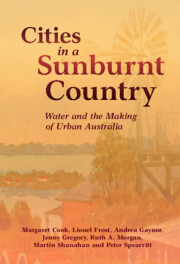Book contents
- Cities in a Sunburnt Country
- Studies in Environment and History
- Cities in a Sunburnt Country
- Copyright page
- Contents
- Figures
- Maps
- Book part
- Tables
- Acknowledgements
- 1 Prologue
- 2 Living Water
- 3 Domesticating Water
- 4 Keeping Up
- 5 Transforming Homes
- 6 Watering Suburbia
- 7 Crises of Confidence
- 8 Twenty-First Century Australian Cities
- 9 Epilogue
- References
- Index
- Studies in Environment and History
1 - Prologue
Published online by Cambridge University Press: 19 May 2022
- Cities in a Sunburnt Country
- Studies in Environment and History
- Cities in a Sunburnt Country
- Copyright page
- Contents
- Figures
- Maps
- Book part
- Tables
- Acknowledgements
- 1 Prologue
- 2 Living Water
- 3 Domesticating Water
- 4 Keeping Up
- 5 Transforming Homes
- 6 Watering Suburbia
- 7 Crises of Confidence
- 8 Twenty-First Century Australian Cities
- 9 Epilogue
- References
- Index
- Studies in Environment and History
Summary
Both Indigenous and non-Indigenous Australians have learnt to cope with climate variability in meeting water needs over a range of time-scales. The five cities are locations that Aboriginal people cared for and maintained relationships with water over tens of thousands of years, knowledge of which is maintained today. In the face of a changing climate and continuing population growth, the five cities face challenges in developing and maintaining sustainable and equitable approaches to water provision and management. Each response to water management problems is shaped by path-dependent effects of earlier decisions and the ‘wicked’ nature of problems that defy simple solutions. The five cities are marked by climatic diversity, and all are at least partly built on floodplains. Each has a distinct relationship with the natural water of its hinterland and the proximity of ocean outlets for sewage disposal.
Keywords
- Type
- Chapter
- Information
- Cities in a Sunburnt CountryWater and the Making of Urban Australia, pp. 1 - 26Publisher: Cambridge University PressPrint publication year: 2022



